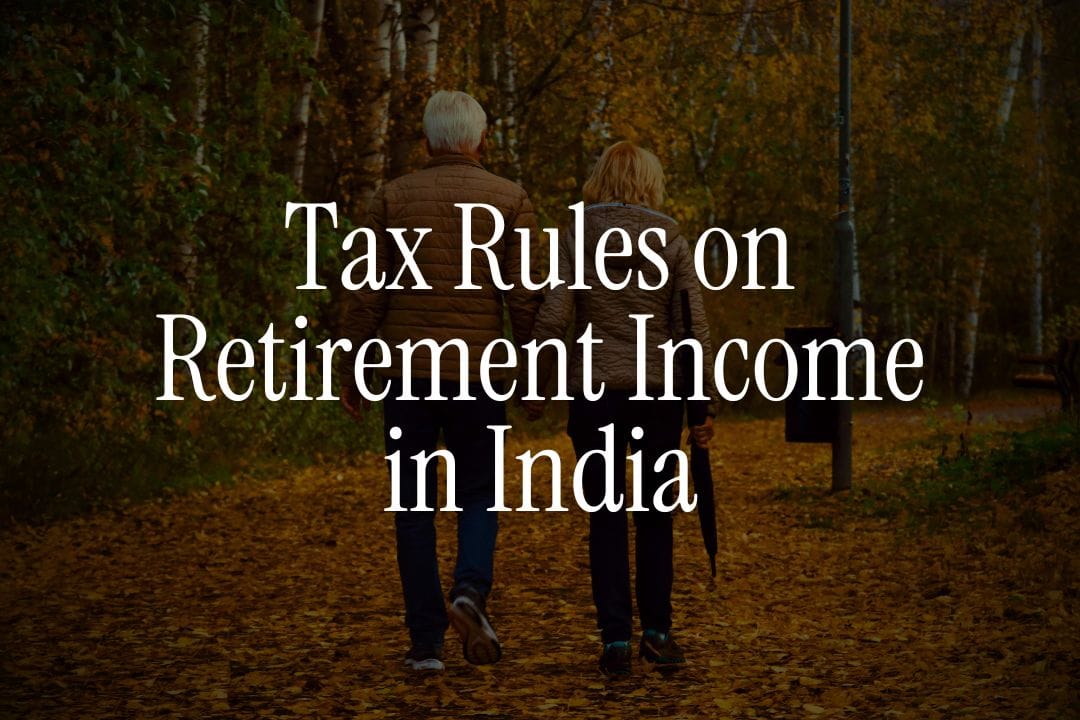
You worked in the UAE for 20 years. Built a solid EPF balance. Contributed to NPS.
Got a pension from your Indian employer.
Now you're planning to retire-maybe back in India, maybe staying abroad.
Then the tax questions hit:
"Do I pay tax on my EPF withdrawal?"
"Is my pension from my Indian employer taxable?"
"What about my 401(k) from my US stint?"
"How much TDS will be deducted?"
"Can I reduce this somehow?"
At Belong, we've worked with thousands of retiring NRIs navigating exactly these questions. Our WhatsApp community has over 8,000 members actively discussing retirement tax planning, and we've seen every scenario imaginable.
Here's what most articles won't tell you upfront: Retirement income taxation for NRIs is complex because your tax liability depends on THREE factors: (1) type of retirement income, (2) your residential status when you receive it, and (3) whether you can claim DTAA benefits.
Get even one wrong, and you could overpay by ₹1-3 lakh annually.
This guide breaks down every type of retirement income an NRI receives, explains the exact tax treatment, shows you legal ways to minimize taxation, and walks you through the filing process with real examples.
By the end, you'll know precisely what you owe, how to reduce it, and what documents you need-no confusion, no surprises.
Quick Reference: What's Taxable (And What's Not)
Before we dive deep, here's your cheat sheet. Bookmark this table.
Retirement Income Type | Taxable or Not? | Tax Rate / Notes | Key Article |
|---|---|---|---|
EPF withdrawal (5+ years service) | Tax-free | No TDS, no tax | Section 10(10) |
EPF withdrawal (\<5 years service) | Taxable | 10% TDS (with PAN) or maximum marginal rate of 34.608% (without PAN) on amount >₹50k | - |
EPF interest (after leaving job) | Depends on withdrawal | Interest is part of accumulated balance; tax-exempt if overall withdrawal qualifies, but may be taxable on accrual if delayed | - |
PPF withdrawal at maturity | Tax-free | No tax, no TDS | Section 10(11) |
NPS: 60% lump sum | Tax-free | Fully exempt | Section 10(12A) |
NPS: 40% annuity purchase | Taxable | Annuity payments taxed at slab rates | - |
Gratuity (private sector) | Partial exemption | Up to ₹20 lakh exempt | Section 10(10) |
Gratuity (government) | Tax-free | Fully exempt | Section 10(10) |
Uncommuted pension (monthly) | Fully taxable | Taxed as salary at slab rates | - |
Commuted pension (lump sum) | Partial/Full exemption | Govt: fully exempt; Private: 1/3 or 1/2 exempt | Section 10(10A) |
Family pension | Partial exemption | ₹25,000 or 1/3, whichever lower, is exempt | - |
Foreign pension (401k, IRA, UK pension) | Depends on status | DTAA may help; Section 89A allows deferral for accounts in notified countries (US, UK, Canada). | Section 89A |
NRE/FCNR FD interest | Tax-free | Zero tax for NRIs | - |
NRO FD interest | Taxable | 30% TDS (12.5% with DTAA for UAE) | - |
Sources: EPFIndia, Income Tax Act 1961, ClearTax Pension Guide, Economic Times
👉 Tip: Use our Residential Status Calculator before calculating your tax liability. Your tax treatment changes dramatically based on whether you're an NRI, RNOR, or Resident.
Also Read -Pravasi Pension Scheme for NRIs & Residents
Understanding Your Residential Status (The Foundation)
This is critical. Your residential status determines what income is taxable in India.
There are three categories:
1. Non-Resident Indian (NRI)
- Only Indian-sourced income is taxable
- Foreign salary, foreign investments, foreign pensions: Not taxable in India
- Indian pensions, EPF interest, NRO FD interest, rental income: Taxable
Who qualifies: You spent less than 182 days in India during the financial year (or less than 60 days this year + 365 days in last 4 years).
or (for Indian citizens/PIO with Indian income exceeding ₹15 lakh) less than 120 days + not liable to tax in any other country (deemed residency rule).
2. Resident but Not Ordinarily Resident (RNOR)
- Indian-sourced income: Taxable
- Foreign-sourced income: Not taxable
- This is the "golden period" for returning NRIs
Who qualifies: You were an NRI for 9 out of 10 previous years OR spent less than 729 days in India in the previous 7 years.
3. Resident
- Global income is taxable in India
- Your US 401(k), Dubai savings account, UK pension-all taxable
Who qualifies: You spent 182+ days in India this year, or you've been a resident for multiple consecutive years.
Also Read - Residential Status Under Section 6 Of Income Tax Act
Why this matters for retirement income:
If you're an NRI living in the UAE and receive an Indian pension, you pay tax in India.
If you're RNOR and receive a foreign pension, you pay zero tax in India on that foreign pension.
If you're a Resident and receive a foreign pension, it's fully taxable in India.
The same pension could be tax-free, partially taxed, or fully taxed depending solely on your residential status.
Check your residential status with our free calculator before proceeding further.
Also Read - Difference Between NRI and Resident Tax Filing in India
EPF Withdrawal: When You Pay Tax (And When You Don't)
The Employees' Provident Fund (EPF) is the most common retirement corpus for salaried Indians. You contributed 12% of your salary, your employer contributed 12%, and it grew at 8.25% annually.
Now you want to withdraw it. What's the tax situation?
The 5-Year Rule
This is the golden rule for EPF taxation:
If you've worked for 5+ years of continuous service (across one or multiple employers), EPF withdrawal is 100% tax-free.
Continuous service means your EPF was transferred from employer to employer without withdrawal. The 5 years can span multiple jobs.
If you withdraw before completing 5 years of service, it's taxable.
TDS on EPF Withdrawal (Before 5 Years)
If you're withdrawing before 5 years:
Amount | PAN Linked? | TDS Rate |
|---|---|---|
Below ₹50,000 | Yes/No | 0% (no TDS) |
Above ₹50,000 | Yes | 10% |
Above ₹50,000 | No | 30% |
For NRIs specifically: If you're an NRI at the time of withdrawal, TDS is 30% (or DTAA rate if you submit TRC) regardless of PAN status, as per Section 195.
Source: EPFO Guidelines
EPF Interest After Leaving Job (Critical for NRIs)
Here's what most NRIs miss:
Once you stop working in India, your EPF account stops receiving contributions but continues to earn interest for up to 3 years of inactivity. This interest is part of the accumulated balance.
After 3 years, the account becomes inoperative and stops earning interest. If the withdrawal is tax-exempt (5+ years of service), the entire balance including post-cessation interest is tax-exempt.
Delaying withdrawal may lead to post-cessation interest being treated as taxable on accrual, though in practice, it's often exempt upon qualified withdrawal.
NRIs are advised to withdraw promptly to avoid potential tax complications.
(Source)
Example:
- You left India on March 31, 2023
- You withdraw EPF on June 1, 2026 (more than 3 years later)
- Interest earned from April 1, 2023 to March 31, 2026 (3 years): Included in balance and tax-exempt if overall withdrawal qualifies (5+ years service).
- You receive no interest after March 31, 2026 (inoperative account dormant account)
- Total withdrawal: Tax-free (assuming 5+ years service)
But if you withdraw on March 1, 2025 (within 3 years):
- Interest earned from April 1, 2023 to March 1, 2025 (that is withdraw within 3 years): Interest earned from April 1, 2023 to March 1, 2025: Included in balance and tax-exempt if overall withdrawal qualifies.
Delaying beyond 3 years means no further interest, but prompt withdrawal avoids any accrual-based tax risks.
👉 Tip: If you're an NRI and have completed 5 years of service, withdraw your EPF immediately after leaving India. Don't wait. The longer you wait, the more taxable interest accumulates. Use EPFO's online withdrawal through the UAN portal-it's completely digital now.
EPF Withdrawal Process for NRIs
You can withdraw EPF online if:
- Your UAN is activated
- PAN is linked to UAN
- Bank account is linked
- Aadhaar is linked (or you file offline with Form 15G/15H)
Online process:
- Go to EPFO Member Portal
- Login with UAN and password
- Navigate to "Online Services" > "Claim (Form-31, 19 & 10C)"
- Select "PF Advance (Form 31)" for full settlement
- Enter bank details (must be the account linked to UAN)
- Submit
Processing time: 3-20 days for amounts below ₹1 lakh, longer for higher amounts.
Offline process (if UAN not KYC-compliant): Fill Composite Claim Form (Aadhaar) or Composite Claim Form (Non-Aadhaar) and submit to your jurisdictional EPFO office.
Detailed step-by-step guide: EPF Withdrawal Online
PPF: Tax-Free at Maturity (With Caveats for NRIs)
Public Provident Fund (PPF) is a 15-year government savings scheme. It offered attractive returns (7.1% as of 2025) and was popular for retirement savings.
Tax treatment:
- PPF withdrawals after maturity (15 years): 100% tax-free
- Interest earned: Tax-free
- No TDS
The NRI problem: Once you become an NRI, you cannot open a new PPF account. Existing PPF accounts can continue till maturity, but you cannot make fresh contributions.
What to do with your existing PPF:
- Let it run till maturity (tax-free withdrawal)
- Don't add money (not allowed as NRI)
- Premature withdrawal before 7 years: Penalty + reduced interest
Read more about PPF rules for NRIs.
Better alternatives for NRIs:
- GIFT City USD Fixed Deposits - Tax-free, higher returns, USD-denominated
- NRE Fixed Deposits - Tax-free interest, repatriable
Pension Income: The Complex One
Pension taxation depends on whether it's commuted (lump sum) or uncommuted (monthly payments), and whether you worked for government or private sector.
Uncommuted Pension (Monthly Payments)
Rule: Fully taxable for everyone-government and private sector employees.
Uncommuted pension is taxed as "Salaries" at your applicable income tax slab rate.
Example: You receive ₹40,000/month pension = ₹4.8 lakh annually
If you're in the 30% tax bracket, you pay ₹1.44 lakh tax.
Your employer/pension payer will deduct TDS every month based on your estimated annual income.
Source: Income Tax on Pension
Commuted Pension (Lump Sum Payment)
When you retire, you can choose to "commute" part of your pension-convert future monthly payments into a lump sum now.
Tax treatment varies:
1. Government Employees: Fully tax-exempt
- No matter how much you commute, it's 100% tax-free
- This includes central government, state government, PSU employees
2. Private Sector Employees:
The exemption depends on whether you receive gratuity.
If you receive both gratuity AND pension:
- Maximum exemption = 1/3 of the value you'd get if 100% pension was commuted
- Remaining 2/3 is taxable
If you receive ONLY pension (no gratuity):
- Maximum exemption = 1/2 of the value you'd get if 100% pension was commuted
- Remaining 1/2 is taxable
This is covered under Section 10(10A) of the Income Tax Act.
Source: Tax on Commuted Pension
Calculating Commuted Pension Exemption
Example 1: Private employee with gratuity
Mr. Sharma retires with:
- Monthly pension: ₹30,000
- He commutes 40% of his pension
- Commuted amount received: ₹15 lakh
If he had commuted 100% of pension:
- Value = ₹30,000 × 12 months × remaining life expectancy (let's say 20 years) = ₹72 lakh (simplified calculation)
Exemption = 1/3 of ₹72 lakh = ₹24 lakh
Since he only received ₹15 lakh, the entire amount is tax-free.
His remaining monthly pension (₹18,000 after commuting 40%) is fully taxable.
Example 2: Private employee without gratuity
Ms. Verma retires with:
- Monthly pension: ₹25,000
- She commutes 50% of her pension
- Commuted amount received: ₹20 lakh
If she had commuted 100% of pension:
- Value = ₹50 lakh (simplified)
Exemption = 1/2 of ₹50 lakh = ₹25 lakh
Since she received ₹20 lakh, the entire amount is tax-free.
Her remaining monthly pension (₹12,500) is fully taxable.
Source: HDFC Life - Pension Taxation
Family Pension (After Death of Employee)
If you're receiving pension because your spouse/parent (who was the employee) passed away, it's called family pension.
Tax treatment:
- Fully taxable under "Income from Other Sources" (not Salaries)
- Exemption: ₹25,000 or 1/3 of pension, whichever is lower
This was increased from ₹15,000 to ₹25,000 for FY 2024-25 onwards.
Example: You receive ₹6 lakh family pension annually.
- Exemption = Lower of (₹25,000 or ₹2 lakh [1/3 of ₹6 lakh])
- Exemption = ₹25,000
- Taxable amount = ₹5.75 lakh
Source: Pension Guide
Gratuity: Tax-Free (Up to a Limit)
Gratuity is a lump sum payment you receive at retirement or resignation (after 5 years of service) as a token of appreciation from your employer.
Tax treatment:
1. Government employees: Fully tax-exempt (no limit)
2. Private sector employees:
Exemption under Section 10(10) is the lowest of:
- ₹20 lakh (increased from ₹10 lakh)
- 15 days' salary × years of service
- Actual gratuity received
Example: You worked for 25 years. Last drawn salary = ₹80,000/month.
Calculation:
- 15 days' salary = (₹80,000 / 26) × 15 = ₹46,154
- Years of service = 25
- Exemption = ₹46,154 × 25 = ₹11.54 lakh
Actual gratuity received = ₹15 lakh
Exempt amount = Lowest of (₹20 lakh, ₹11.54 lakh, ₹15 lakh) = ₹11.54 lakh
Taxable amount = ₹15 lakh - ₹11.54 lakh = ₹3.46 lakh
This ₹3.46 lakh will be added to your income and taxed at your slab rate.
Source: Income Tax Department - Retirement Benefits
Also Read - How Inflation in India Impacts Your Retirement Savings
NPS Withdrawals: 60% Tax-Free, 40% Taxable
National Pension Scheme (NPS) is a government retirement scheme where you invest during your working years and receive a corpus at retirement.
At retirement (age 60 or after 10 years of contribution):
You must:
- Withdraw at least 60% as lump sum OR
- Purchase annuity with at least 40% of corpus
Tax treatment:
1. 60% lump sum withdrawal: 100% tax-free (Section 10(12A))
2. 40% used to buy annuity:
- Annuity purchase: Not taxable
- Annuity payments (monthly pension): Fully taxable at slab rates
Example: NPS corpus at retirement = ₹50 lakh
- You withdraw 60% = ₹30 lakh (tax-free)
- You buy annuity with 40% = ₹20 lakh (not taxed now)
- Annuity pays you ₹15,000/month = ₹1.8 lakh/year (fully taxable annually)
Partial withdrawals (before retirement): Allowed after 3 years for specific purposes (medical, education, house). Up to 25% of your contribution (not corpus) can be withdrawn. This is tax-free.
Premature exit (before 60 years):
- 80% must be used to buy annuity (only 20% can be withdrawn as lump sum)
- The 20% lump sum is taxable
Read detailed NPS guide for NRIs.
👉 Tip: NRIs can continue contributing to NPS even while abroad. NPS allows equity exposure (up to 75%) and has delivered 9-12% returns historically, making it attractive for long-term retirement planning.
Foreign Retirement Accounts: Section 89A Changes Everything
If you worked in the US, UK, Canada, Australia, or similar countries, you likely have a foreign retirement account-401(k), IRA, UK pension, superannuation, etc.
The problem: Many foreign countries tax retirement income at withdrawal (when you take money out).
India used to tax it on accrual (every year as it grows).
This created double taxation and cash flow nightmares-you'd pay Indian tax on money you hadn't even received yet.
Section 89A fixes this.
Introduced in Finance Act 2021, Section 89A allows you to defer taxation in India until you actually withdraw the money, aligning with how the foreign country taxes it.
Who Can Use Section 89A?
You qualify if:
- You opened the retirement account while you were an NRI
- The account is in a "notified country" (US, UK, Canada, Australia, Singapore, and many others-check Income Tax Department notifications)
- The foreign country taxes withdrawals, not accruals
- You're now a Resident of India
How It Works
Without Section 89A: You return to India. Your 401(k) earns $10,000 interest this year. India immediately taxes that $10,000 (even though you haven't withdrawn it). The US doesn't tax it yet. You pay Indian tax with no foreign tax credit available.
With Section 89A: You file Form 10-EE. India doesn't tax the $10,000 interest now. Years later, when you withdraw from the 401(k), the US taxes it. India taxes it in that same year. You can now claim Foreign Tax Credit in India for US taxes paid, avoiding double taxation.
How to Claim Section 89A
- File Form 10-EE online on the Income Tax portal before your ITR due date
- Form 10-EE must be filed every year you want the deferral
- Once you opt for Section 89A for a specific account, the choice is irrevocable for that account
- In your ITR, don't include the accrued income from that foreign retirement account
Read our detailed guide on avoiding double taxation on retirement income and Section 89A specifics.
DTAA Benefits on Foreign Pensions
If you're still an NRI or RNOR when receiving foreign pension income, DTAA (Double Taxation Avoidance Agreement) may provide better relief than Section 89A.
For example:
- Under India-UAE DTAA Article 19, private pensions from India to UAE residents are taxable only in UAE (which is zero tax)
- Under India-US DTAA, pensions may be taxed at reduced rates or you can claim Foreign Tax Credit
Check our guide on India-UAE DTAA benefits for retiring NRIs.
TDS on Retirement Income: What Gets Deducted
Tax Deducted at Source (TDS) is tax your employer/bank/pension payer deducts before paying you.
Here's what TDS applies to your retirement income:
Income Type | TDS Rate (for Residents) | TDS Rate (for NRIs) | Section |
|---|---|---|---|
Uncommuted pension | As per estimated annual income | 30% (or DTAA rate) | 192 |
EPF withdrawal (\<5 years) | 10% (if PAN linked, amount >₹50k) | 30% (or DTAA rate) | 192A |
NPS withdrawal (taxable portion) | 10% | 30% | 194 |
Annuity payments | As per estimated annual income | 30% | 194 |
NRO FD interest | 10% (residents) | 30% (or DTAA rate) | 195 |
31.2% | 31.2% (or DTAA rate) | 194-I |
For NRIs: TDS is generally 30% unless you submit a Tax Residency Certificate (TRC) and claim DTAA benefits (e.g., 12.5% on interest under India-UAE DTAA).
For Residents: TDS is based on your projected annual income. Your payer estimates your total income and deducts accordingly.
How to reduce TDS:
- Submit Form 15G/15H (if you're a resident senior citizen and total income is below taxable limit)
- Get a Lower TDS Certificate under Section 197 from the Income Tax Department if your actual tax liability is lower
- Submit TRC and Form 10F (if you're an NRI claiming DTAA benefits)
After TDS is deducted, you must file ITR and reconcile. If excess TDS was deducted, you'll get a refund.
Also Read -DTAA for NRI Bank Interest: Can You Avoid 30% TDS Legally
How to File ITR for Retirement Income
Filing income tax returns (ITR) is mandatory if your income exceeds the basic exemption limit (₹2.5 lakh for those below 60, ₹3 lakh for seniors 60-80, ₹5 lakh for super seniors 80+).
Even if your income is below this, file if:
- TDS was deducted (you want refund)
- You have high-value transactions (property sale, large FD investments)
- You want to maintain a clean tax record
Which ITR Form to Use?
For NRIs:
- ITR-2: Most common. Use if you have salary/pension, rental income, capital gains (no business income)
- ITR-3: If you have business/profession income
For Residents with retirement income:
- ITR-1 (Sahaj): If income is from salary/pension, one house property, and other sources, and total income is below ₹50 lakh
- ITR-2: If you have capital gains or multiple house properties
Note: NRIs cannot file ITR-1. They must use ITR-2 or ITR-3.
Source: Income Tax Department
How to Report Retirement Income in ITR
1. Pension income:
- ITR-1: Go to "Salary" section > Nature of Employment > Select "Pensioners"
- ITR-2: Schedule S (Salary) > Select type of employer (CG Pensioners, SG Pensioners, PSU Pensioners, Other Pensioners)
- Enter gross pension, standard deduction (₹50,000), exemptions (commuted pension under 10(10A))
2. EPF withdrawal:
- If tax-free: Report under "Exempt Income" section
- If taxable: Report under "Income from Salary" and include TDS
3. Gratuity:
- Exempt portion: Report under Section 10(10) in "Exempt Income"
- Taxable portion: Report under "Income from Salary"
4. NPS withdrawal:
- 60% lump sum: Report under Section 10(12A) as exempt
- Annuity payments: Report under "Income from Other Sources"
5. NRO FD interest:
- Report under "Income from Other Sources"
- Claim DTAA benefit (if applicable) in Schedule TR (Tax Relief)
- Upload TRC as supporting document
6. Foreign pension:
- If Section 89A applies: Don't report accrued income; report only when withdrawn
- If DTAA applies: Report in Schedule FSI (Foreign Source Income) and claim relief in Schedule TR
Read our step-by-step NRI ITR filing guide for detailed instructions.
Documents needed:
- Form 26AS (TDS certificate-download from income tax portal)
- Form 16 (from employer/pension payer)
- Form 16A (from banks for interest TDS)
- Bank statements
- Investment proofs (for deductions)
- TRC and Form 10F (if claiming DTAA benefits)
- Form 10-EE (if claiming Section 89A benefits)
ITR filing deadline:
- July 31 of the assessment year (for individuals not requiring audit)
- For FY 2024-25, the deadline has been extended to September 15, 2025
File early to avoid last-minute rush and penalties.
Also Read - Step-by-Step Guide: Closing Mutual Fund Investments Before Returning From Abroad
Tax-Saving Strategies for Retirement Income
Here's how to legally minimize your retirement income tax:
1. Time Your Return to India to Maximize RNOR Status
RNOR status gives you 2 years where foreign income is not taxable in India.
Strategy: Return to India after you've been an NRI for 9+ years. Use those 2 RNOR years to:
- Withdraw foreign retirement account balances (not taxable in India during RNOR period)
- Sell foreign assets
- Repatriate foreign income
After RNOR ends, you become a Resident and global income becomes taxable.
2. Withdraw EPF Immediately After Leaving India
If you've completed 5 years of service, EPF withdrawal is tax-free. The sooner you withdraw, the less taxable interest accumulates.
Don't let it sit for years earning taxable interest.
3. Choose NRE Over NRO Fixed Deposits
NRE FD interest is tax-free in India. NRO FD interest faces 30% TDS (12.5% with DTAA).
If you don't need the rupee corpus for India expenses, move funds from NRO to NRE or GIFT City USD FDs (also tax-free).
4. Use GIFT City for Tax-Free Retirement Income
GIFT City (Gujarat International Finance Tec-City) offers USD fixed deposits with tax-free interest.
Benefits:
- Zero tax (no TDS, no income tax)
- USD-denominated (protects against rupee depreciation)
- Up to 4.0-6.0% returns
- Fully repatriable
Compare GIFT City FD rates vs traditional options.
At Belong, we've helped thousands of NRIs shift retirement savings to GIFT City for tax-free growth. Download the app to explore GIFT City investments.
5. Claim All Available Deductions
Even NRIs can claim:
- Section 80C: Up to ₹1.5 lakh for ELSS, PPF (if you were contributing before becoming NRI), life insurance premiums, NPS
- Section 80D: Up to ₹25,000 (₹50,000 for seniors) for health insurance premiums
- Section 80TTB: Up to ₹50,000 deduction on interest income for senior citizens (not available to NRIs, only residents)
- Standard deduction: ₹50,000 on salary/pension income
6. Submit TRC and Form 10F for DTAA Benefits
If you're an NRI in a DTAA country (like UAE), claim reduced TDS rates:
- Interest TDS: 12.5% instead of 30%
- Pensions may be exempt (Article 19 of India-UAE DTAA)
Process:
- Get TRC from your country of residence
- File Form 10F online
- Submit both to your bank/pension payer
Detailed guide: Form 10F for NRIs
7. Don't Forget Section 89 Relief (For Arrears)
If you receive pension arrears or delayed payments in a lump sum, it may push you into a higher tax bracket.
Section 89 allows you to spread the tax liability across the years the arrears relate to, reducing your effective tax rate.
File Form 10E along with your ITR to claim this relief.
8. Convert to New Tax Regime if Beneficial
From FY 2023-24, the new tax regime is the default. It has lower slab rates but fewer deductions.
Compare both regimes:
- Old regime: Higher rates, but you can claim 80C, 80D, HRA, etc.
- New regime: Lower rates, but limited deductions (only ₹50,000 standard deduction, employer NPS contribution)
Use a tax calculator to see which saves you more. For retirees with limited deductions, the new regime may be better.
Read our comparison: Old vs New Tax Regime.
Real Retirement Tax Example (With Numbers)
Let's put everything together with a realistic scenario.
Meet Rajiv:
- Age: 60, retired from private sector job in India
- Worked for 28 years (5+ years continuous service)
- Lives in Dubai (still an NRI)
- Planning to return to India in 2 years
His retirement income sources:
1. EPF withdrawal:
- Balance: ₹65 lakh
- Service: 28 years (>5 years)
- Tax: Zero (fully exempt)
2. Gratuity:
- Received: ₹18 lakh
- Calculation: 15 days' salary × 28 years = ₹14 lakh (exempt under Section 10(10))
- Tax on ₹18 lakh - ₹14 lakh = ₹4 lakh (taxable)
3. Commuted pension:
- He commuted 40% of pension
- Lump sum received: ₹12 lakh
- He also received gratuity, so exemption = 1/3 of 100% commutation value
- 100% commutation value = ₹35 lakh (estimated)
- Exemption = ₹11.67 lakh
- Tax on ₹12 lakh - ₹11.67 lakh = ₹33,000 (taxable)
4. Uncommuted pension (monthly):
- ₹25,000/month after commuting 40%
- Annual: ₹3 lakh
- Fully taxable
Also Read -Best NRO Accounts
5. NRO FD interest:
- ₹40 lakh FDs at 7.5% = ₹3 lakh interest
- As NRI with UAE DTAA: TDS at 12.5% = ₹37,500
- Taxable: ₹3 lakh (after claiming DTAA)
Also Read -NRE vs NRO vs FCNR
6. Rental income from Mumbai flat:
- ₹35,000/month = ₹4.2 lakh annually
- Less: 30% standard deduction = ₹2.94 lakh taxable
- Taxable: ₹2.94 lakh
Also Read -Taxation on Rental Income in India for NRIs
Total Income:
- EPF: ₹0 (exempt)
- Gratuity: ₹4 lakh (taxable portion)
- Commuted pension: ₹0.33 lakh (taxable portion)
- Uncommuted pension: ₹3 lakh
- Interest: ₹3 lakh
- Rental: ₹2.94 lakh
- Total taxable income: ₹13.27 lakh
Tax calculation (Old regime, assuming Rajiv opts for it):
Slab | Amount | Tax |
|---|---|---|
Up to ₹2.5 lakh | ₹2.5 lakh | ₹0 |
₹2.5-5 lakh | ₹2.5 lakh | ₹12,500 (5%) |
₹5-10 lakh | ₹5 lakh | ₹1,00,000 (20%) |
₹10-13.27 lakh | ₹3.27 lakh | ₹98,100 (30%) |
Total tax | ₹2,10,600 |
Add 4% cess = ₹8,424 Final tax: ₹2,19,024
Less: TDS already deducted (₹37,500 on interest) Balance tax to pay: ₹1,81,524
How Rajiv can reduce this:
Move ₹20 lakh from NRO FDs to GIFT City USD FDs: Saves ₹18,750 in TDS + reduces taxable income by ₹1.5 lakh (interest on that portion). Tax saving: ₹63,750
Claim Section 80D deduction: Pay ₹25,000 health insurance premium (he's 60+, so limit is ₹25,000). Tax saving: ₹7,500
Delay return to India by 1 year to stay NRI for one more year and avoid tax on foreign income if he has any.
Revised tax liability: ₹1,10,274 (down from ₹2,19,024)
Annual savings: ₹1,08,750
This is the power of tax planning.
Common Mistakes That Cost Retirees Thousands
Mistake 1: Not Linking PAN to EPF Before Withdrawal
If your PAN isn't linked to your UAN, EPFO deducts 30% TDS (instead of 10%) even if your service is less than 5 years.
Fix: Link PAN through the UAN portal before withdrawing.
Also Read -How to Link Aadhaar and PAN to Your NRI Bank Account
Mistake 2: Waiting Too Long to Withdraw EPF as NRI
Every month your EPF sits dormant (after you stop working), it may earn taxable interest. Withdraw immediately after leaving India if you've completed 5 years of service.
Mistake 3: Not Claiming DTAA Benefits
Many NRIs pay 30% TDS on NRO interest when they could pay just 12.5% (UAE DTAA rate) by submitting TRC and Form 10F.
This mistake costs ₹17,500 per lakh of interest annually.
Also Read -The Complete DTAA Guide for NRIs: How to Avoid Double Taxation on Your Indian Income
Mistake 4: Not Filing ITR (Because "TDS Was Already Deducted")
Even if TDS was deducted, you must file ITR to:
- Claim refunds if excess TDS was deducted
- Report all income and stay compliant
- Avoid notices from the Income Tax Department
Not filing ITR can result in penalties up to ₹5,000.
Also Read - How to File Income Tax Return in India as an NRI
Mistake 5: Ignoring Section 89A for Foreign Retirement Accounts
If you have a 401(k) or foreign pension and return to India, not filing Form 10-EE means India taxes the accrued income immediately-even before you withdraw it.
This creates cash flow problems and double taxation.
Mistake 6: Not Converting to Resident Status When Required
Some NRIs try to maintain "NRI" status to avoid tax on global income, even when they're living in India 200+ days a year.
This is tax evasion. The Income Tax Department can impose penalties and prosecute.
Use our Residential Status Calculator to determine your correct status.
Mistake 7: Assuming All Pensions Are Taxable the Same Way
Government pensions, private pensions, commuted, uncommuted-all have different tax rules. Don't assume. Check the specific section that applies to your pension type.
Your Next Steps
Retirement income taxation doesn't have to be confusing. Here's what to do right now:
This Week:
- Determine your residential status: Use our calculator to know if you're NRI, RNOR, or Resident
- List all retirement income sources: EPF, pension, gratuity, NPS, FD interest, rental income, foreign pensions
- Estimate your tax: Use the rules in this guide to calculate your approximate tax liability
This Month:
- Withdraw EPF if eligible: If you've completed 5+ years of service and left India, withdraw EPF to avoid taxable interest
- Submit TRC and Form 10F: If you're an NRI, get DTAA benefits to reduce TDS
- File Form 10-EE: If you have foreign retirement accounts, claim Section 89A benefits
This Quarter:
- Restructure your portfolio: Move some funds from NRO FDs to GIFT City USD FDs for tax-free income
- File your ITR: Even if you're still an NRI, file on time (deadline: July 31 or extended date) to claim refunds and stay compliant
- Join our community: Over 8,000 NRIs in our WhatsApp group share tax-saving strategies, CA recommendations, and real experiences
Need Help?
- Download the Belong app to explore tax-free GIFT City investments
- Use our Compliance Compass to ensure you're following all tax and investment rules
- Read our detailed guides on NRI taxation, DTAA benefits, and retirement planning
Sources:
- Income Tax Act 1961
- ClearTax - Income Tax for NRIs
- ClearTax - Are Pensions Taxable?
- ClearTax - EPF Withdrawal Taxability
- ClearTax - Section 89A
- EPFO Official Portal
- GoINRI - EPF Guide for NRIs
- GoINRI - Income Tax on Retirement Benefits
- HDFC Life - Income Tax on Pension
- Income Tax Department - Taxability of Retirement Benefits
- Tax2win - Income Tax for Pensioners
- Tax2win - Income Tax for NRIs
- TaxGuru - Section 10(10A) Exemption




